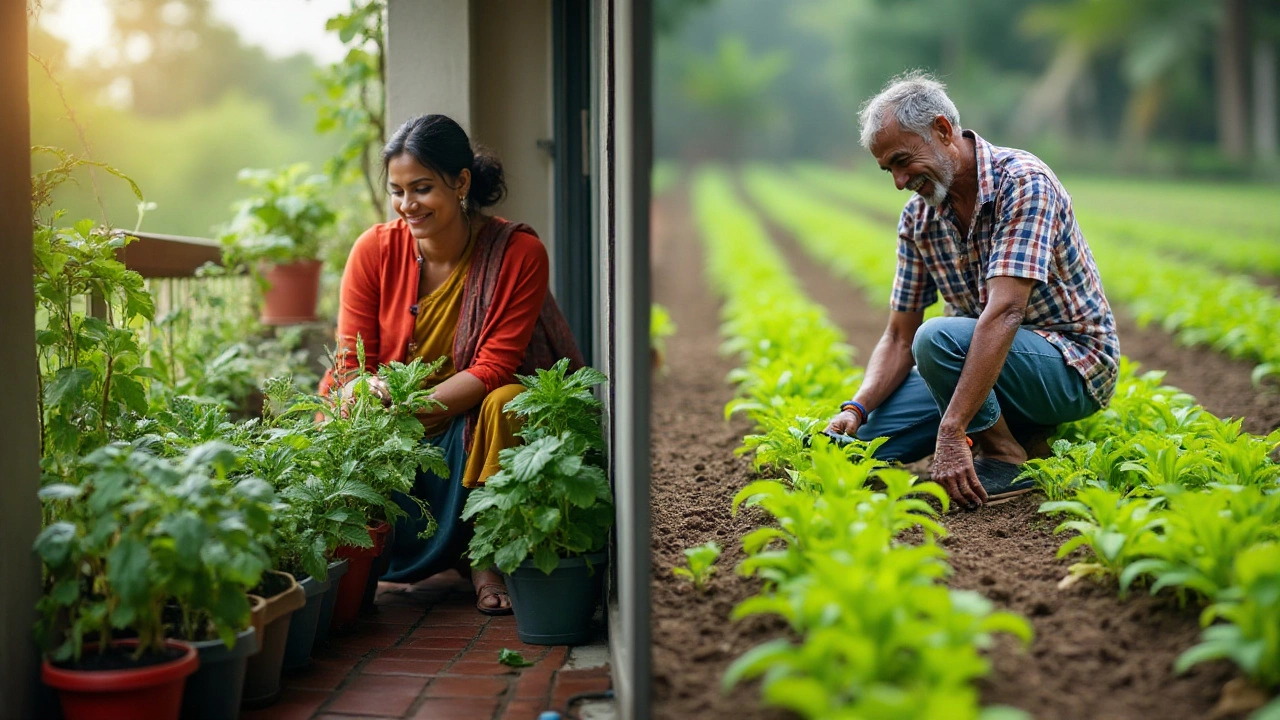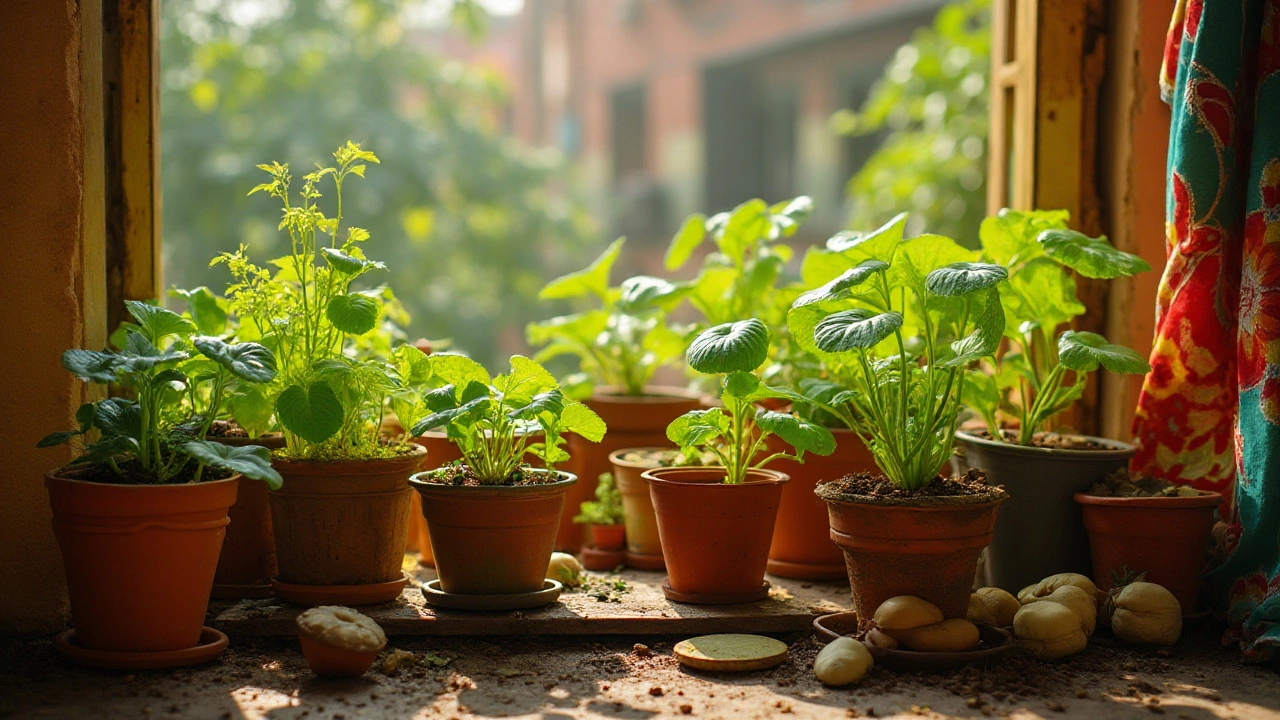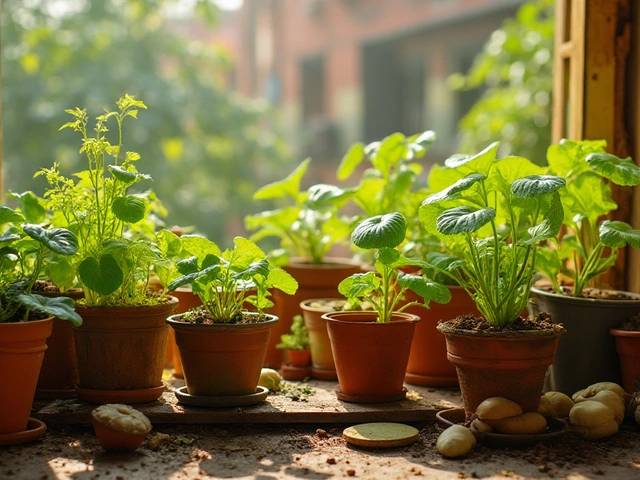In the world of kitchen gardening, the decision to plant vegetables in pots or directly in the ground often hinges on a gardener's unique needs and circumstances. Each method comes with its own set of perks and compromises, inviting gardeners to weigh what matters most—be it space, convenience, or potential yield.
Container gardening, for instance, opens up the joys of homegrown produce to those with limited space. It offers flexibility and ease, making it an accessible option for urban gardeners who wish to transform a balcony or a small patio into a lush green haven. On the flip side, planting vegetables directly in the ground can lead to more abundant harvests, as it allows plants to stretch their roots deeper into the nutrient-rich earth.
Whether you're leaning towards the compact elegance of pots or the traditional approach of ground planting, understanding the particulars of each will help you cultivate a thriving vegetable garden. Let's delve deeper into these methods, uncovering the advantages, challenges, and tips to ensure your gardening journey is as fruitful as possible.
- Container Gardening Advantages
- Benefits of Ground Planting
- Challenges and Considerations
- Tips for a Successful Vegetable Harvest
Container Gardening Advantages
Container gardening offers a world of possibilities, especially appealing to those whose gardening ambitions are curbed by limited space. With the rise of urbanization, a significant number of people find themselves nesting in apartments or homes with petite yards. Luckily, growing vegetable gardening in pots doesn't just make it possible to cultivate a garden without sprawling land—it opens up an opportunity to bring the bounty of a harvest home, right from a balcony or a small patio.
One of the sweet spots of container gardening is mobility. The ability to move pots as the sun shifts or as seasons change offers a tactical advantage over traditional plots. This flexibility means plants can always bask in the best light conditions available, enhancing growth efficiency. Such adaptability is invaluable during unpredictable weather, allowing plants to be sheltered easily from the gusty winds or heavy rains that could otherwise cause harm. It also makes managing temperature-sensitive plants simpler, extending your growing season.
The control over soil conditions is another compelling perk. Unlike the ground, where soil composition might not always suit certain plants, pots allow you to tailor the soil's composition to individual plant needs. You can mix in amendments like peat or perlite to adjust drainage or nutrients, ensuring each plant gets exactly what it needs to thrive. This customization helps in avoiding common soil-borne diseases and pests, minimizing the reliance on chemical interventions and promoting organic gardening practices.
"Container gardening not only maximizes small spaces but allows you to cultivate a healthier ecosystem by reducing pest infestations," suggests Ellen Jenkins, author of 'Urban Gardening: Growing Edibles Anywhere'.
Container gardening also fosters an environment conducive to experimentation. With pots, you can try out different plant varieties to see which fares better under your home's specific conditions. Herbs can share space with vegetables, creating productive and aesthetically pleasing arrangements that double as fresh and fragrant additions to any dish. Moreover, this approach can translate into a lower initial investment, especially suitable for those new to gardening and hesitant to commit to larger plots.
However, to successfully grow vegetables in containers, it helps to follow particular guidelines. Selecting the right pot size is crucial, as each vegetable variety has its own rooting depth requirements. For instance, shallow-rooted plants like lettuce can thrive in smaller pots, whereas deep-rooted ones like tomatoes or carrots demand more room. Regular watering is paramount, as pots tend to dry out faster than the ground, especially under the summer sun. Using mulch atop the soil can help retain moisture, reducing the frequency of watering while maintaining healthy soil levels.
The allure of container gardening continues to bloom, showcasing a balance of aesthetic appeal and practical function, transforming ordinary spaces into verdant retreats. Whether on a windowsill or a rooftop, the joy of watching seeds transform into lush plants is a reward in itself, no matter how modest or grand the garden.

Benefits of Ground Planting
Ground planting, often seen as the traditional backbone of vegetable gardening, comes with a host of advantages that contribute to a bountiful harvest. When you plant directly into the soil, plants have the freedom to spread their roots far and wide. This access to a larger volume of soil allows them to draw on a broad reservoir of nutrients, promoting robust growth and increasing the likelihood of a higher yield. Unlike containers, the ground retains moisture more effectively due to its expansive surface area, which can be a lifesaver during the hotter months when evaporation rates soar. With the natural absorption of excess rainwater and the drainage of excess close to the surface, ground soil offers a balance that pots may struggle to achieve without constant attention from the gardener.
Moreover, the expansive nature of ground planting means there’s more room for creative planting strategies. Unlike the confines of a pot, you have the flexibility to implement crop rotation, companion planting, and even intercropping. These methods can enhance soil health, control pests naturally, and optimize the use of available space. Soils, when nurtured year after year, develop a rich biodiversity of microorganisms that improve soil structure and health, fostering an ecosystem that supports various plant needs. Ground planting not only caters to the immediate needs of plants but also contributes to long-term soil fertility, making it a sustainable choice for gardeners.
A statistic from the National Gardening Association reveals that plants in the ground can yield up to 30% more produce than those confined to containers. This striking difference is often attributed to the vast root networks that plants develop when unrestricted by pot boundaries. As plants mature through seasons, they benefit from the changing conditions that the open environment offers—variations in sunlight, rain, and wind all play a part in strengthening plant resilience. Additionally, the cost-effectiveness of planting in the ground cannot be understated. While pots and potting soil can add up financially, using native soil and compost enhances your garden's sustainability and budget-friendliness.
"There is something deeply satisfying about tucking your seedlings directly into the earth," says gardening expert Monty Don. "It's as if you're connecting with the garden's winding root system, engaging in an age-old tradition that yields not just food, but a sense of fulfillment."
Furthermore, when considering ecosystems, ground planting supports biodiversity. Your garden can become a thriving habitat for beneficial insects, earthworms, and other critters that significantly contribute to a healthy garden ecosystem. The intricate web of life established around ground plants can help manage pests naturally and promote pollination, contributing to unmatched garden productivity and health. So, while deciding between containers and the earth, consider the term 'grounding'—there's a reason it signifies connection and stability, much like the deep anchoring your plants receive when they're grown in the ample space of the earth.

Challenges and Considerations
Embarking on a vegetable gardening project, whether through container gardening or ground planting, presents several challenges and considerations that are crucial to address for a bountiful harvest. The first hurdle often revolves around understanding the specific needs of the vegetables you're growing. Different plants have varying requirements in terms of space, soil type, and water. For instance, root vegetables like carrots thrive better when they have ample room to grow downwards, making ground planting a preferable choice unless you have particularly deep containers.
Climate poses another significant challenge. Plants in pots can dry out quicker, especially during hot summers, necessitating more frequent watering compared to those planted in the ground. Wind can be a rogue element as well, more so for potted plants, which are more susceptible to being knocked over by gusty conditions. Therefore, finding a sheltered spot or using sturdy pots is important. However, such aspects also provide a level of control, allowing gardeners to shield delicate plants from harsh weather more easily than those anchored in the garden.
Soil quality is yet another critical factor. While ground planting benefits from richer soil environments where nutrients can be consistent and abundant, container gardening often requires the gardener to invest in quality potting mixes and routine fertilization. According to the Royal Horticultural Society, "a balanced potting mix can make a significant difference in plant health," highlighting the need for periodic soil amendments in containers to sustain plant growth over time.
Moreover, the consideration of pest control varies between these methods. Potted plants can sometimes be moved indoors or to a different location if pest infestation arises. This mobility is advantageous; however, pests can quickly exploit the isolated environments of containers, leading to rapid infestations. In contrast, ground planting presents its challenges, where an infestation can spread easily in an open garden environment.
Finally, space is a perpetual consideration. While ground planting requires a favorable plot with suitable soil conditions, which may be scarce for some urban gardeners, containers offer versatility in placement. This flexibility is ideal for those who wish to maximize small urban spaces, like balconies or rooftops, but comes with its constraints on plant size and type. With space often influencing sunlight exposure, it's vital to ensure that plants receive enough light, which might involve rotating pots frequently or choosing strategic locations for ground gardens to avoid overshadowing by buildings or trees.
The delicate dance of balancing these challenges and considerations makes the very act of growing vegetables a learning process, driven by experimentation and adaptation. Recognizing these factors early on can lead to informed gardening decisions, paving the way for a productive and enjoyable gardening season, no matter the environment.

Tips for a Successful Vegetable Harvest
Growing your own vegetables, whether in pots or the open ground, can be a rewarding journey, rich with learning and patience. To secure a bountiful vegetable gardening harvest, attention to detail is key. Start by understanding the specific needs of each plant species you are nurturing. Vegetables like tomatoes, peppers, and cucumbers often flourish in pots, where their drainage and sun exposure can be diligently managed. On the other hand, deep-rooted plants such as carrots and potatoes might require the expansive space of a garden bed to thrive to their fullest potential.
One crucial aspect in both container gardening and ground planting is soil preparation. For containers, use a high-quality potting mix that’s specially formulated to hold moisture while providing excellent drainage. This prevents the common pitfall of waterlogged roots. If planting directly in the ground, it’s beneficial to enrich the soil with organic compost, improving its structure and nutrient content. Regular soil testing can guide you in amending your garden with the right nutrients, ensuring that your plants have the best possible conditions to grow.
"To plant a garden is to believe in tomorrow," once said Audrey Hepburn, highlighting not only the hopefulness but the long-term planning that successful gardening entails.
Watering is another area where precision pays off. For both methods, it’s vital to water deeply and infrequently rather than lightly and often. This encourages roots to grow deeper, fostering resilience in hot weather. In ground planting, employing a drip irrigation system can conserve water and apply it slowly and directly to where it’s needed most. With pots, consider the weight and size, as larger containers retain moisture longer than smaller ones. Always check the soil moisture level before watering to avoid over-saturation.
Sunlight is the lifeblood of a hearty vegetable garden. Most vegetables crave full sun, defined as six to eight hours of direct sunlight per day. Observe your garden at various times to choose the optimal spot for ground planting or arranging pots. Rotate your pots as needed to capture the sun’s path, and consider companion planting in the ground to maximize light usage and natural pest control. A strategic garden layout not only optimizes light but also airflow, reducing the risk of fungal diseases.
Finally, regular maintenance cannot be overstated. This includes pruning your plants to remove dead or diseased leaves, which, if neglected, can limit air circulation and promote the spread of illness. Monitoring for pests such as slugs and aphids is equally essential, using natural deterrents like neem oil or companion plants like marigolds which repel unwanted visitors. Picking vegetables at their peak ripeness ensures they concentrate their energy on new growth, rather than sustaining overly mature fruits. Employing these practices not only ensures a thriving garden but enriches your experience and satisfaction as a gardener.





